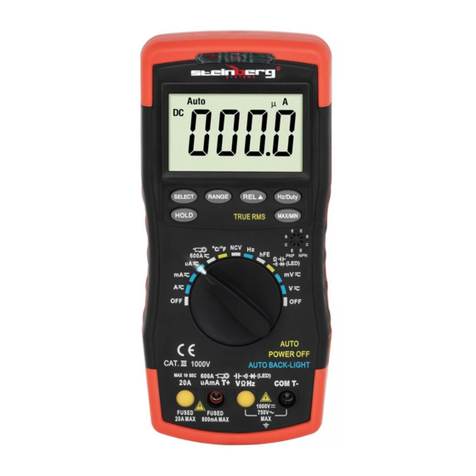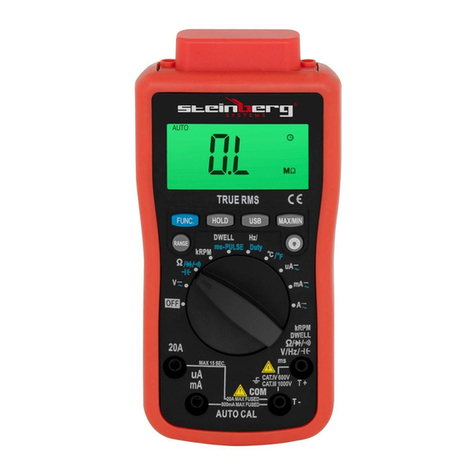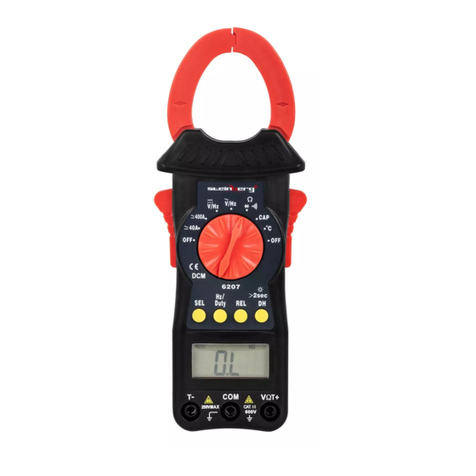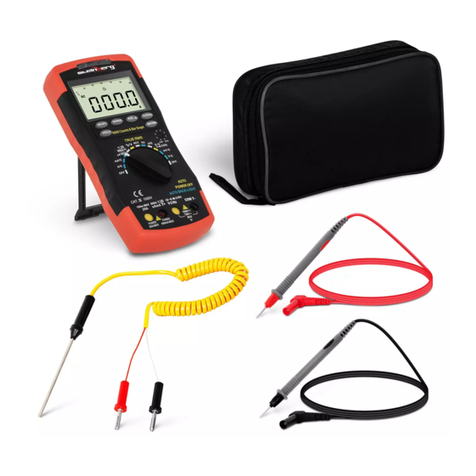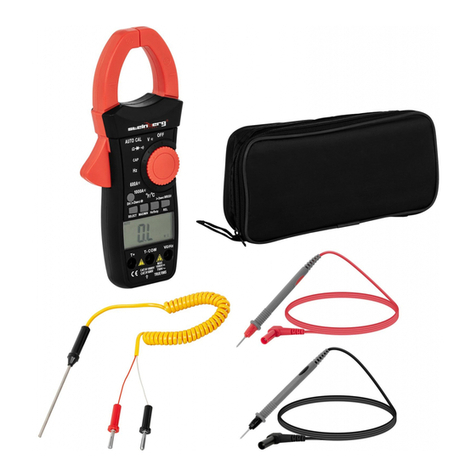
14 15
09.07.2019
UWAGA! Pomimo iż urządzenie zostało
zaprojektowane tak aby było bezpieczne, posiadało
odpowiednie środki ochrony oraz pomimo użycia
dodatkowych elementów zabezpieczających
użytkownika, nadal istnieje niewielkie ryzyko
wypadku lub odniesienia obrażeń w trakcie pracy
z urządzeniem. Zaleca się zachowanie ostrożności i
rozsądku podczas jego użytkowania.
3. ZASADY UŻYTKOWANIA
Urządzenie jest przeznaczone do wykonywania pomiarów
odległości, powierzchni oraz kubatury.
Odpowiedzialność za wszelkie szkody powstałe
w wyniku użytkowania niezgodnego z przeznaczeniem
ponosi użytkownik.
3.1. OPIS URZĄDZENIA
3.2. PRZYGOTOWANIE DO PRACY
UMIEJSCOWIENIE URZĄDZENIA
Temperatura otoczenia powinna wynosić od 18°C
do 28°C (64°F to 82°F), a wilgotność względna nie
powinna przekraczać 70%. Urządzenie należy ustawić
w sposób zapewniający dobrą cyrkulację powietrza.
Należy utrzymać minimalny odstęp 10 cm od każdej
ściany urządzenia. Urządzenie należy trzymać z dala od
wszelkich gorących powierzchni. Urządzenie należy zawsze
użytkować na równej, stabilnej, czystej, ognioodpornej
i suchej powierzchni i poza zasięgiem dzieci oraz osób
ograniczonych funkcjach psychicznych, sensorycznych i
umysłowych. Urządzenie należy umiejscowić w taki sposób,
by w dowolnej chwili można się było dostać do wtyczki
sieciowej. Należy pamiętać o tym, by zasilanie urządzenia
energią odpowiadało danym podanym na tabliczce
znamionowej! Przed pierwszym użyciem zdemontować
wszystkie elementy i umyć je jak również umyć całe
urządzenie.
3.3. PRACA Z URZĄDZENIEM
UWAGA: Symbol oraz opis umieszczony przy gniazdach
wejściowych oznacza poziom napięcia oraz natężenia,
który nie może być przekraczany gdyż może spowodować
utratę życia lub zdrowia oraz uszkodzenie multimetra.
UWAGA! Rysunki produktu znajdują się na końcu
instrukcji na stronie 38.
1. Detektor napięcia (NCV)
2. Czujnik CDS
3. Czerwona dioda: detekcja napięcia
4. Zielona dioda: detekcja napięcia
5. Wyświetlacz LCD.
6. Przycisk POWER, włącza lub wyłącza urządzenie.
7. Przycisk HOLD: Blokowanie/ odblokowywanie
wyświetlanej wartości.
8. Przycisk NCV, włączanie (zielona lampka )/
wyłączanie trybu mierzenia bezkontaktowego.
9. Pokrętło: wybór funkcji i zakresu pomiaru.
10. Gniazdo wejściowe: mA T+, używane podczas
odczytu kondensatora, mA i temperatury „+”.
11. Gniazdo wejściowe: 20A.
12. Gniazdo wejściowe: Ω VΩHz: V / 200kHz.
13. Gniazdo wejściowe: T COMT-: COM i temperatura „-”.
14. Gniazdo wejściowe: hFE
PL
UWAGA: Przed rozpoczęciem pomiaru upewnić się że
Pokrętło: wybór funkcji i zakresu pomiaru jest ustawione
na prawidłowym zakresie pomiaru.
UWAGA: Jeśli nie ma pewności co do skali wartości
mierzonego prądu, należy ustawić przełącznik zakresu w
najwyższej pozycji
UWAGA: Jeśli na ekranie zostanie wyświetlona cyfra 1 lub
-1, oznacza to wykroczenie wartości mierzonej poza skalę
wybranego zakresu. Należy zwiększyć mierzony zakres i
ponowić pomiar.
UWAGA: W przypadku, gdy na wyświetlaczu urządzenia
pojawi się informacja o zużyciu baterii i potrzebie jej
wymiany na nową, należy wymienić je bez zbędnej zwłoki.
3.3.1. POMIAR NAPIĘCIA DC
a) Ustawić pokrętło na pozycji V ”
b) Podłączyć czarny przewód pomiarowy do gniazda
COMT a czerwony do gniazda VΩHz.
c) Przyłożyć sondy pomiarowe do testowanego
obwodu
d) Zmierzona wartość wyświetli się na ekranie LCD.
Wskazana zostanie polaryzacja czerwonego
przewodu, wraz z wartością napięcia DC.
3.3.2. POMIAR NAPIĘCIA AC
a) Ustawić pokrętło na pozycji V~.
b) Podłączyć czarny przewód pomiarowy do gniazda
COMT a czerwony do gniazda VΩHz
c) Dotknąć testowany obwód obiema sondami
d) Zmierzona wartość wyświetli się na ekranie LCD.
• „ ” Oznacza że nie można wprowadzać
napięcia większego niż 750V, Grozi to
uszkodzeniem urządzenia
3.3.3. POMIAR NATĘŻENIA DC
a) Ustawić pokrętło w pozycji A
b) Podłączyć czarny przewód pomiarowy do gniazda
COMT a czerwony do mAT+ dla maksymalnego
pomiaru w zakresie 200mA. Dla pomiaru natężenia
w zakresie od 200mA do 20 A podłączyć czerwony
przewód do gniazda 20A
c) Dotknąć testowany obwód obiema sondami.
d) Zmierzona wartość wyświetli się na ekranie LCD.
Wyświetlona zostanie polaryzacja czerwonej sondy
wraz z wartością prądu.
• Oznacza że maksymalny pomiar gniazda
nie przekroczy 200mA
• Pomiar w zakresie 20A nie powinien być dłuższy
niż 10 s, zmniejszy to ryzyko przegrzania
przewodów.
3.3.4. POMIAR NATĘŻENIA AC
a) Ustawić pokrętło w pozycji “A~”
b) Podłączyć czarną sondę pomiarową do gniazda
COMT a czerwoną do mAT+ dla maksymalnego
pomiary w zakresie 200mA. Dla pomiaru w zakresie
od 200mA do 20A należy podłączyć czerwony
przewód do gniazda 20A.
c) Dotknąć testowany obwód obiema sondami
d) Zmierzona wartość wyświetli się na ekranie LCD.
• Oznacza że maksymalny pomiar gniazda
nie przekroczy 200mA
• Pomiar podczas korzystania z gniazda 20A nie
powinien być dłuższy niż 10 s aby zmniejszyć
ryzyko przegrzania obwodu.
3.3.5. POMIAR OPORNOŚCI
a) Ustawić pokrętło w pozycji Ω
b) Podłączyć czarną sondę do gniazda COMT a
czerwona do gniazda VΩHz
c) Dotknąć testowany obwód obiema sondami
d) zmierzona wartość wyświetli się na ekranie LCD
• Maksymalny odczyt to 500V rms< 10sec
• Uwaga: Jeśli na ekranie zostanie wyświetlona
cyfra 1 lub -1, oznacza to wykroczenie wartości
mierzonej poza skalę wybranego zakresu.
Należy zwiększyć mierzony zakres i ponowić
pomiar.
• Aby zmierzyć oporność powyżej 10M Ω,
multimetr będzie potrzebował chwili aby
ustabilizować odczyt.
• Jeśli obwód jest otwarty multimetr wyświetli
wartość „1” lub „-1”.
• Podczas pomiaru upewnij się że obwód jest
odłączony od źródła zasilania oraz, że wszystkie
kondensatory są rozładowane.
3.3.6. POMIAR POJEMNOŚCI
a) Ustawić pokrętło w pozycji „F°”
b) Podłączyć czarną sondę do gniazda COMT a
czerwoną do gniazda mAT+
c) Dotknąć testowany obwód obiema sondami
d) Zmierzona wartość wyświetli się na ekranie
• Kondensatory powinny być rozładowane zanim
Pojemność będzie mierzona
3.3.7. POMIAR TEMPERATURY
a) Ustawić pokrętło w pozycji “°C”
b) Podłączyć czarną sensor do gniazda COMT a
czerwoną do gniazda mAT+
c) Dotknąć obszaru którego temperatura będzie
mierzona
d) Zmierzona wartość wyświetli się na ekranie LCD
• Limit pomiarowy termopary to 250°C. Do
pomiarów wyższych temperatur należy użyć
dostosowanej do wyższego zakresu temperatur
sondy pomiarowej.
• Zachowaj konsekwencję podczas mierzenia
temperatury
3.3.8. POMIAR CZĘSTOTLIWOŚCI
a) Ustawić pokrętło w pozycji 200kHz
b) Podłączyć czarną sondę do gniazda COMT a
czerwoną sondę do gniazda VΩHz
c) Dotknąć testowany obwód obiema sondami
d) Zmierzona wartość wyświetli się na ekranie
3.3.9. TESTOWANIE DIODY I DŹWIĘKU
a) Ustawić pokrętło w pozycji
b) Podłączyć czarną sondę do gniazda COMT a
czerwoną do gniazda VΩHz
c) Podłączyć sondy pomiarowe do mierzonej diody, na
wyświetlaczu wyświetli się wartość napięcia
d) Podczas testowania sygnału dźwiękowego podłączyć
sondy testowe do dwóch punktów obwodu. Jeśli
opór obwodu jest mniejszy niż 50 Ω urządzenie wyda
z siebie sygnał dźwiękowy.
• Podczas testu upewnij się że obwód jest
odłączony od źródła zasilania oraz, że wszystkie
kondensatory są rozładowane
3.3.10. TESTOWANIE TRANZYSTORA HFE
a) Ustawić pokrętło w pozycji „hFE”
b) Określić czy jest to tranzystor NPN czy PNP i
zlokalizować przewody emitera, bazy i kolektora.
PL
W przypadku gdy, naklejki są nieczytelne należy je
wymienić.
i) Zachować instrukcję użytkowania w celu jej
późniejszego użycia. W razie, gdyby urządzenie miało
zostać przekazane osobom trzecim, to wraz z nim
należy przekazać również instrukcję użytkowania.
PAMIĘTAJ! Należy chronić dzieci i inne osoby
postronne podczas pracy urządzeniem.
2.3. BEZPIECZEŃSTWO OSOBISTE
a) Niedozwolone jest obsługiwanie urządzenia
w stanie zmęczenia, choroby, pod wpływem alkoholu,
narkotyków lub leków, które ograniczają w istotnym
stopniu zdolności obsługi urządzenia.
b) Urządzenie nie jest przeznaczone do tego, by
było użytkowane przez osoby (w tym dzieci)
o ograniczonych funkcjach psychicznych,
sensorycznych i umysłowych lub nieposiadające
odpowiedniego doświadczenia i/lub wiedzy, chyba że
są one nadzorowane przez osobę odpowiedzialną za
ich bezpieczeństwo lub otrzymały od niej wskazówki
dotyczące tego, jak należy obsługiwać urządzenie.
c) Należy być uważnym, kierować się zdrowym
rozsądkiem podczas pracy urządzeniem. Chwila
nieuwagi podczas pracy, może doprowadzić do
poważnych obrażeń ciała.
d) Aby zapobiegać przypadkowemu uruchomieniu
upewnij się, że przełącznik jest w pozycji wyłączonej
przed podłączeniem do źródła zasilania.
e) Urządzenie nie jest zabawką. Dzieci powinny być
pilnowane, aby nie bawiły się urządzeniem.
2.4. BEZPIECZNE STOSOWANIE URZĄDZENIA
a) Nie należy używać urządzenia, jeśli przełącznik ON/
OFF nie działa sprawnie (nie załącza i nie wyłącza
się). Urządzenia, które nie mogą być kontrolowane
za pomocą przełącznika są niebezpieczne, nie mogą
pracować i muszą zostać naprawione.
b) Nieużywane urządzenia należy przechowywać
w miejscu niedostępnym dla dzieci oraz osób
nieznających urządzenia lub tej instrukcji
obsługi. Urządzenia są niebezpieczne w rękach
niedoświadczonych użytkowników.
c) Utrzymywać urządzenie w dobrym stanie
technicznym.
d) Urządzenie należy chronić przed dziećmi.
e) Naprawa oraz konserwacja urządzeń powinna być
wykonywana przez wykwalikowane osoby przy
użyciu wyłącznie oryginalnych części zamiennych.
Zapewni to bezpieczeństwo użytkowania.
f) Aby zapewnić zaprojektowaną integralność
operacyjną urządzenia, nie należy usuwać
zainstalowanych fabrycznie osłon lub odkręcać śrub.
g) Zabrania się przesuwania, przestawiania i obracania
urządzenia będącego w trakcie pracy.
h) Nie należy pozostawiać włączonego urządzenia bez
nadzoru.
i) Należy regularnie czyścić urządzenie, aby nie
dopuścić do trwałego osadzenia się zanieczyszczeń.
j) Urządzenie nie jest zabawką. Czyszczenie
i konserwacja nie mogą być wykonywane przez dzieci
bez nadzoru osoby dorosłej.
k) Nigdy nie mierzyć wartości napięcia, gdy przewody
pomiarowe są podłączone do gniazd pomiarowych
wartości natężenia prądu.
l) Zachować ostrożność podczas pracy przy napięciu
powyżej DC60V lub AC42V.
m) Podczas wykonywania pomiaru trzymać przewody
pomiarowe lub sondy za izolowane części.
n) Wybrać odpowiednią funkcję i zakres pomiarowy dla
pomiaru, aby uniknąć uszkodzenia miernika.
o) Odłączyć przewody pomiarowe od punktów
testowych przed przejściem do innej funkcji.
